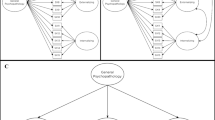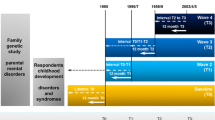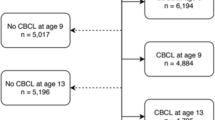Abstract
Recent studies have suggested that the structure of psychopathology may be usefully represented in terms of a general factor of psychopathology (p-factor) capturing variance common to a broad range of symptoms transcending diagnostic domains in addition to specific factors capturing variance common to smaller subsets of more closely related symptoms. Little is known about how the general co-morbidity captured by this p-factor develops and whether general co-morbidity increases or decreases over childhood and adolescence. We evaluated two competing hypotheses: 1) dynamic mutualism which predicts growth in general co-morbidity and associated p-factor strength over time and 2) p-differentiation which predicts that manifestations of liabilities towards psychopathology become increasingly specific over time. Data came from the Zurich Project on the Social Development of Children and Youths (z-proso), a longitudinal study of a normative sample (approx. 50 % male) measured at 8 time points from ages 7 to 15. We operationalised general co-morbidity as p-factor strength in a bi-factor model and used omega hierarchical to track how this changed over development. In contrast to the predictions of both dynamic mutualism and p-differentiation, p-factor strength remained relatively constant over the studied period suggesting that such processes do not govern the interplay between psychopathological symptoms during this phase of development. Future research should focus on earlier phases of development and on factors that maintain the consistency of symptom-general covariation across this period.


Similar content being viewed by others
References
Asparouhov, T., & Muthén, B. (2009). Exploratory structural equation modeling. Structural Equation Modeling: A Multidisciplinary Journal, 16, 397–438.
Averdijk, M., Zirk-Sadowski, J., Ribeaud, D., & Eisner, M. (2016). Long-term effects of two childhood psychosocial interventions on adolescent delinquency, substance use, and antisocial behavior: a cluster randomized controlled trial. Manuscript submitted for publication.
Barlow, D. H., Sauer-Zavala, S., Carl, J. R., Bullis, J. R., & Ellard, K. K. (2014). The nature, diagnosis, and treatment of neuroticism back to the future. Clinical Psychological Science, 2, 344–365.
Bartels, M., Rietveld, M. J. H., Van Baal, G. C. M., & Boomsma, D. I. (2002). Genetic and environmental influences on the development of intelligence. Behavior Genetics, 32, 237–249.
Bartholomew, D. J., Deary, I. J., & Lawn, M. (2009). A new lease of life for Thomson’s bonds model of intelligence. Psychological Review, 116, 567–579.
Behar, L., & Stringfield, S. (1974). Manual for the preschool behavior questionnaire. Durham: Lenore Behar.
Borsboom, D., & Cramer, A. O. (2013). Network analysis: an integrative approach to the structure of psychopathology. Annual Review of Clinical Psychology, 9, 91–121.
Borsboom, D., Cramer, A. O., Schmittmann, V. D., Epskamp, S., & Waldorp, L. J. (2011). The small world of psychopathology. PloS One, 6, e27407.
Caspi, A., Houts, R. M., Belsky, D. W., Goldman-Mellor, S. J., Harrington, H., Israel, S., Meier, M. H., Shalev, I., Poulton, R., & Moffitt, T. E. (2014). The p factor: One general psychopathology factor in the structure of psychiatric disorders? Clinical Psychological Science, 2, 119–137.
Cicchetti, D., & Rogosch, F. A. (2002). A developmental psychopathology perspective on adolescence. Journal of Consulting and Clinical Psychology, 70, 6–20.
Cole, D. A., Peeke, L. G., Martin, J. M., Truglio, R., & Seroczynski, A. D. (1998). A longitudinal look at the relation between depression and anxiety in children and adolescents. Journal of Consulting and Clinical Psychology, 66, 451–460.
Cramer, A. O., Waldorp, L. J., van der Maas, H. L., & Borsboom, D. (2010). Comorbidity: a network perspective. Behavioral and Brain Sciences, 33, 137–150.
Edelbrock, C., Costello, A. J., Dulcan, M. K., Kalas, R., & Conover, N. C. (1985). Age differences in the reliability of the psychiatric interview of the child. Child Development, 265-275.
Gignac, G. E. (2014). Dynamic mutualism versus g factor theory: an empirical test. Intelligence, 42, 89–97.
Gorsuch, R. L. (1983). Factor analysis (2nd ed.). Hillsdale: LEA.
Grice, J. W. (2001). Computing and evaluating factor scores. Psychological Methods, 6, 430–450.
Harrison, D. A., McLaughlin, M. E., & Coalter, T. M. (1996). Context, cognition, and common method variance: psychometric and verbal protocol evidence. Organizational Behavior and Human Decision Processes, 68, 246–261.
Holzinger, K. J., & Swineford, F. (1937). The bi-factor method. Psychometrika, 2, 41–54.
Kessler, R. C., Chiu, W. T., Demler, O., & Walters, E. E. (2005). Prevalence, severity, and comorbidity of 12-month DSM-IV disorders in the National Comorbidity Survey Replication. Archives of General Psychiatry, 62, 617–627.
Krueger, R. F., & Markon, K. E. (2006). Reinterpreting comorbidity: a model-based approach to understanding and classifying psychopathology. Annual Review of Clinical Psychology, 2, 111–133.
Laceulle, O. M., Vollebergh, W. A., & Ormel, J. (2015). The structure of psychopathology in adolescence: Replication of a general psychopathology factor in the TRAILS study. Clinical Psychological Science, epub ahead of print.
Lahey, B. B., Applegate, B., Waldman, I. D., Loft, J. D., Hankin, B. L., & Rick, J. (2004). The structure of child and adolescent psychopathology: generating new hypotheses. Journal of Abnormal Psychology, 113, 358–385.
Lahey, B. B., Van Hulle, C. A., Singh, A. L., Waldman, I. D., & Rathouz, P. J. (2011). Higher-order genetic and environmental structure of prevalent forms of child and adolescent psychopathology. Archives of General Psychiatry, 68, 181–189.
Lahey, B. B., Applegate, B., Hakes, J. K., Zald, D. H., Hariri, A. R., & Rathouz, P. J. (2012). Is there a general factor of prevalent psychopathology during adulthood? Journal of Abnormal Psychology, 121, 971–977.
Lahey, B. B., Rathouz, P. J., Keenan, K., Stepp, S. D., Loeber, R., & Hipwell, A. E. (2015). Criterion validity of the general factor of psychopathology in a prospective study of girls. Journal of Child Psychology and Psychiatry, 56, 415–422.
Malti, T., Ribeaud, D., & Eisner, M. P. (2011). The effectiveness of two universal preventive interventions in reducing children’s externalizing behavior: a cluster randomized controlled trial. Journal of Clinical Child & Adolescent Psychology, 40, 677–692.
Masten, A. S., & Cicchetti, D. (2010). Developmental cascades. Development and Psychopathology, 22, 491–495.
Maxwell, S. E., & Delaney, H. D. (1993). Bivariate median splits and spurious statistical significance. Psychological Bulletin, 113, 181–190.
McDonald, R. P. (1999). Test theory: A unified treatment. Mahwah: LEA.
Morin, A. J., Arens, A. K., & Marsh, H. W. (2016). A bifactor exploratory structural equation modeling framework for the identification of distinct sources of construct-relevant psychometric multidimensionality. Structural Equation Modeling: A Multidisciplinary Journal, 23, 116–139.
Murray, A. L., & Johnson, W. (2013). The limitations of model fit in comparing the bi-factor versus higher-order models of human cognitive ability structure. Intelligence, 41, 407–422.
Murray, A. L., Booth, T., McKenzie, K., Kuenssberg, R., & O’Donnell, M. (2014a). Are autistic traits measured equivalently in individuals with and without an autism spectrum disorder? An invariance analysis of the Autism Spectrum Quotient Short Form. Journal of Autism and Developmental Disorders, 44, 55–64.
Murray, A. L., McKenzie, K., Kuenssberg, R., & O’Donnell, M. (2014b). Are we under- estimating the association between autism symptoms?: The importance of considering simultaneous selection when using samples of individuals who meet diagnostic criteria for an Autism Spectrum Disorder. Journal of Autism and Developmental Disorders, 44, 2921–2930.
Murray, A. L., Eisner, M. P., & Ribeaud, D. (2016). The need for dimensional, trans-diagnostic measures of childhood and adolescent psychopathology: an analysis of the Social Behavior Questionnaire. Manuscript submitted for publication.
Muthén, B., & Asparouhov, T. (2012). Bayesian structural equation modeling: a more flexible representation of substantive theory. Psychological Methods, 17, 313–335.
Nagin, D., & Tremblay, R. E. (1999). Trajectories of boys’ physical aggression, opposition, and hyperactivity on the path to physically violent and nonviolent juvenile delinquency. Child Development, 70, 1181–1196.
Noordhof, A., Krueger, R. F., Ormel, J., Oldehinkel, A. J., & Hartman, C. A. (2015). Integrating autism-related symptoms into the dimensional internalizing and externalizing model of psychopathology. The TRAILS study. Journal of Abnormal Child Psychology, 43, 577–587.
Ormel, J., Raven, D., van Oort, F., Hartman, C. A., Reijneveld, S. A., Veenstra, R., & Oldehinkel, A. J. (2015). Mental health in Dutch adolescents: a TRAILS report on prevalence, severity, age of onset, continuity and co-morbidity of DSM disorders. Psychological Medicine, 45, 345–360.
Patalay, P., Fonagy, P., Deighton, J., Belsky, J., Vostanis, P., & Wolpert, M. (2015). A general psychopathology factor in early adolescence. The British Journal of Psychiatry, 207, 15–122.
Podsakoff, P. M., MacKenzie, S. B., & Podsakoff, N. P. (2012). Sources of method bias in social science research and recommendations on how to control it. Annual Review of Psychology, 63, 539–569.
R Core Team. (2014). R: A language and environment for statistical computing. Vienna: R Foundation for statistical computing. http://www.R-project.org .
Reise, S. P., & Waller, N. G. (2009). Item response theory and clinical measurement. Annual Review of Clinical Psychology, 5, 27–48.
Reise, S. P., Scheines, R., Widaman, K. F., & Haviland, M. G. (2013). Multidimensionality and structural coefficient bias in structural equation modelling: a bifactor perspective. Educational and Psychological Measurement, 73, 5–26.
Revelle, W., & Wilt, J. (2012). On when a factor is a general factor: Presented at the European Association for Personality Psychology experts meeting on the structure of personality, Dubrovnik, Croatia.
Revelle, W., & Wilt, J. (2013). The general factor of personality: a general critique. Journal of Research in Personality, 47, 493–504.
Rhemtulla, M., Brosseau-Liard, P. É., & Savalei, V. (2012). When can categorical variables be treated as continuous? A comparison of robust continuous and categorical SEM estimation methods under suboptimal conditions. Psychological Methods, 17, 354.
Roberts, B. W., Walton, K. E., & Viechtbauer, W. (2006). Patterns of mean-level change in personality traits across the life course: a meta-analysis of longitudinal studies. Psychological Bulletin, 132, 1–25.
Rutter, M. (1967). A children’s behaviour questionnaire for completion by teachers: preliminary findings. Journal of Child Psychology and Psychiatry, 8, 1–11.
Rutter, M. (1997). Comorbidity: concepts, claims and choices. Criminal Behaviour and Mental Health, 7, 265–285.
Schmid, J., & Leiman, J. M. (1957). The development of hierarchical factor solutions. Psychometrika, 22, 53–61.
Spearman, C. (1904). “General Intelligence,” objectively determined and measured. The American Journal of Psychology, 15, 201–292.
Stochl, J., Khandaker, G. M., Lewis, G., Perez, J., Goodyer, I. M., Zammit, S., & Jones, P. B. (2015). Mood, anxiety and psychotic phenomena measure a common psychopathological factor. Psychological Medicine, 45, 1483–1493.
Tackett, J. L., Lahey, B. B., Van Hulle, C., Waldman, I., Krueger, R. F., & Rathouz, P. J. (2013). Common genetic influences on negative emotionality and a general psychopathology factor in childhood and adolescence. Journal of Abnormal Psychology, 122, 1142–1153.
ten Berge, J. M. F., Krijnen, W. P., Wansbeek, T., & Shapiro, A. (1999). Some new results on correlation-preserving factor scores prediction methods. Linear Algebra and its Applications, 289, 311–318.
Tremblay, R. E., Loeber, R., Gagnon, C., Charlebois, P., Larivee, S., & LeBlanc, M. (1991). Disruptive boys with stable and unstable high fighting behavior patterns during junior elementary school. Journal of Abnormal Child Psychology, 19, 285–300.
Tucker-Drob, E. M., & Briley, D. A. (2014). Continuity of genetic and environmental influences on cognition across the life span: a meta-analysis of longitudinal twin and adoption studies. Psychological Bulletin, 140, 949–979.
Van Buuren, S., & Groothuis-Oudshoorn, K. (2011). mice: Multivariate imputation by chained equations in R. Journal of Statistical Software, 45, 1–67.
van Der Maas, H. L., Dolan, C. V., Grasman, R. P., Wicherts, J. M., Huizenga, H. M., & Raijmakers, M. E. (2006). A dynamical model of general intelligence: the positive manifold of intelligence by mutualism. Psychological Review, 113, 842–861.
van Lier, P. A., Vitaro, F., Barker, E. D., Brendgen, M., Tremblay, R. E., & Boivin, M. (2012). Peer victimization, poor academic achievement, and the link between childhood externalizing and internalizing problems. Child Development, 83, 1775–1788.
Weir, K., & Duveen, G. (1981). Further development and validation of the prosocial behaviour questionnaire for use by teachers. Journal of Child Psychology and Psychiatry, 22, 357–374.
Wright, A. G., Krueger, R. F., Hobbs, M. J., Markon, K. E., Eaton, N. R., & Slade, T. (2013). The structure of psychopathology: toward an expanded quantitative empirical model. Journal of Abnormal Psychology, 122, 281–294.
Ye, S. (2009). Factor structure of the General Health Questionnaire (GHQ-12): the role of wording effects. Personality and Individual Differences, 46, 197–201.
Yung, Y. F., Thissen, D., & McLeod, L. D. (1999). On the relationship between the higher- order factor model and the hierarchical factor model. Psychometrika, 64, 113–128.
Acknowledgments
We are grateful to the children, parents and teachers who provided data for the z-proso study and the research assistants involved in its collection. Funding from the Jacobs the Swiss National Science Foundation and the Swiss Federal Office of Public Health is also gratefully acknowledged.
Author information
Authors and Affiliations
Corresponding author
Ethics declarations
Funding
This study received funding from the Jacobs Foundation (Grant 2010-888) and the Swiss National Science Foundation (Grants 100013_116829 & 100014_132124).
Conflict of Interest
Aja Louise Murray declares that she has no conflict of interest. Manuel Eisner declares that he has no conflict of interest. Denis Ribeaud declares that he has no conflict of interest.
Ethical Approval
All procedures performed in studies involving human participants were in accordance with the ethical standards of the institutional and/or national research committee and with the 1964 Helsinki declaration and its later amendments or comparable ethical standards.
Informed Consent
Informed consent was obtained from all individual participants included in the study.
Rights and permissions
About this article
Cite this article
Murray, A.L., Eisner, M. & Ribeaud, D. The Development of the General Factor of Psychopathology ‘p Factor’ Through Childhood and Adolescence. J Abnorm Child Psychol 44, 1573–1586 (2016). https://doi.org/10.1007/s10802-016-0132-1
Published:
Issue Date:
DOI: https://doi.org/10.1007/s10802-016-0132-1




